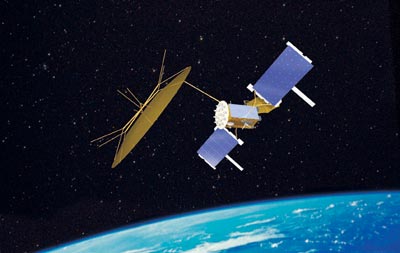The US Navy: lost in space?by Taylor Dinerman
|
| A recent NRC report found that in nine out of sixteen vital areas of space expertise, the Navy rates a “red” for effectiveness. |
This will not be because the Navy lacks a history of supporting and building innovative space systems. The Navstar GPS system can trace its roots directly back to the Navy’s Transit series of satellites, first launched in 1964 to support the Polaris and Poseidon classes of ballistic missile submarines. The Naval Research Lab (NRL) was also responsible for one of America’s first electronic intelligence satellites, the GRAB payload on the Solar Radiation satellites first launched in June of 1960. More recently, along with the Strategic Defense Initiative Organization (now the Missile Defense Agency, MDA) and the Lawrence Livermore National Laboratory, NRL built and operated the innovative 1994 Clementine Moon mission. These are just a few examples of the Navy’s proud record in space operations.
Therefore, it is surprising to read in the National Research Council’s (NRC) recent report on “The Navy’s Needs in Space for Providing Future Capabilities” that in nine out of sixteen vital areas of space expertise, the Navy rates a “red” for effectiveness, signifying “little or no evidence of responsive naval management actions.” These include things such as “space science and technology priorities, programs and funding” and “operational requirements for space and space related systems,” and perhaps worst of all, “recommendations on priorities for space support to the naval warfighter.” Judging by this aspect of the report, it looks like the Navy is willing to let the Air Force set the priorities and pay the price for almost all of America’s spacepower programs.
The Navy’s top leaders admittedly have a lot on their minds these days. In addition to the war on terror and its ramifications, they are also trying to push a few very expensive new shipbuilding programs through Congress and at the same time to justify continuing other troubled programs such as the LPD -17 amphibious warfare ship. One sign that the Navy has been mostly ignoring space is that they have not significantly updated their basic space policy guidance since 1993.
One area where the Navy has been working effectively is in the Ultra High Frequency (UHF) communications area. They are managing two satellite programs for the DoD, the UHF Follow On (UFO), the last of which was launched in 2003, and the Mobile User Objective System (MUOS), currently under development. As far as we know both these programs are reasonably healthy.
Where the Navy seems to be missing the boat is in programs like GPS 3 and Space Based Radar (SBR), where they have not been as engaged in defining the requirements or in providing technical support as could be expected. The Navy is a prime GPS user and if the SBR is ever built and launched, the Navy will come to depend on it just as they now depend on GPS. The National Research Council report warns, “The Navy will be much more successful in assuring that its needs are met if it can contribute the needed up-front involvement and provide incremental funding.”
This has its effects on the Navy’s need for a constant flow of sophisticated earth science data. Several programs that were needed to maintain the US edge in combat meteorology and oceanography (METOC) were canceled and, so far, nothing seems to have come along to replace them. In particular, the Navy/NASA Geosynchronous Imaging Fournier Transform Spectrometer - Indian Ocean METOC Imager (GIFTS-IOMI) was canceled in 2003 because of schedule and possibly technology readiness problems. As of now there have not been any plans to fill the hole this cancellation left in America’s global earth studies network.
| One sign that the Navy has been mostly ignoring space is that they have not significantly updated their basic space policy guidance since 1993. |
If business as normal goes on, the Navy’s principal center of space expertise, the NRL’s Naval Center for Space Technology (NCST), will be a shadow of its former self within a few years. This organization has an excellent reputation. For example, it came up with the Interim Propulsion Module for the ISS, which was canceled but provided NASA with a realistic alternative to Russian boosters back in 2000–2001. The NRC makes an excellent suggestion that the NCST cooperate with the Air Force’s Space Battlelab on integrating data from an experimental space-based hyperspectral sensor with data from a laser radar sensor.
The bright spot for Navy space is in the ballistic missile defense area, where tests with the SM-3 interceptor have gone well. Even under nearly realistic scenarios this missile, launched from Aegis radar-equipped destroyers and cruisers, has performed according to expectations. The MDA and the Navy have shown they can work well together, and this should be an example for other joint programs.
The Navy has a lot to offer to the US military space effort and of course it uses space assets as much or more, than the other services. The NRC report should serve as a warning flare for the Navy’s leadership: their responsibilities for their part of America’s overall spacepower cannot be neglected. In spite of all the other pressures that they have to deal with, Navy space deserves more attention that it has recently been given.
